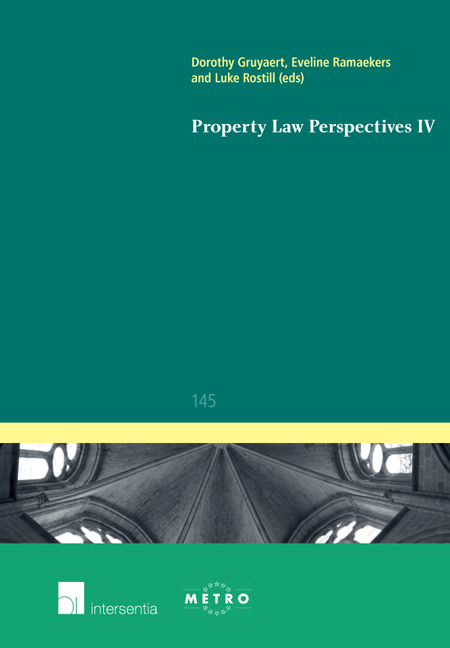Book contents
- Frontmatter
- Preface
- Contents
- Retention of Title v. Immovable Incorporation
- (Alternatives to) the Sale of Churches
- The First in Time Rule in Historical Context
- Paul Krugerbrug Revisited: State Action with an Excessive Impact on Property Rights from a Comparative Perspective
- The Reappearance of Ownership as a Means of Security in Mexican and French Law, the Battles Between Legal Technique and Legal Policy in Insolvency Law
- On the Unity or Disunity of Acquisitive and Extinctive Prescription. Or How Daring Reinterpretations are not Always Right
- Ius Commune Europaeum
Retention of Title v. Immovable Incorporation
Published online by Cambridge University Press: 21 September 2018
- Frontmatter
- Preface
- Contents
- Retention of Title v. Immovable Incorporation
- (Alternatives to) the Sale of Churches
- The First in Time Rule in Historical Context
- Paul Krugerbrug Revisited: State Action with an Excessive Impact on Property Rights from a Comparative Perspective
- The Reappearance of Ownership as a Means of Security in Mexican and French Law, the Battles Between Legal Technique and Legal Policy in Insolvency Law
- On the Unity or Disunity of Acquisitive and Extinctive Prescription. Or How Daring Reinterpretations are not Always Right
- Ius Commune Europaeum
Summary
Introduction
The retention of title is known as a strong security right because the holder remains the owner of the transferred assets until the underlying claim is fulfilled. However, the retained title is likely to be pushed aside when the assets are no longer identifiable in the purchaser's patrimony. Difficulties will arise in particular in the event that the assets sold under retention of title are incorporated into real property, ie attached to a real property in such a strong manner that they become part of that property. It is a basic principle of law that incorporation of a thing into a (real or personal) property, causes the owner of the main asset to gain ownership over the item incorporated into his property. Thus, the landowner acquires ownership over the newly incorporated item while the seller's retained right of ownership is compromised.
The new act on moveable security rights promulgated recently by the Belgian Parliament changed the impact of immovable incorporation on this security right severely in Belgian law. This inspired us to examine the interaction between a retention of title clause and the incorporation into real property of the sold items more thoroughly in this paper. We will start with a brief outline of the concept and legal consequences of the retention of title in Belgian as well as Dutch and French law. Subsequently, the impact made by immovable incorporation of the transferred assets will be discussed. The changes made to the effectiveness of a retention of title by the new Belgian act will be examined in the last chapter even though the act has not yet become effective.
Retention of title: concept and legal consequences
The reservation of ownership as security device
The legal arrangement of the retention of title entails the reservation of ownership in the assets to the seller until the price is fully paid, notwithstanding that the assets are already delivered to the buyer.
- Type
- Chapter
- Information
- Property Law Perspectives IV , pp. 1 - 18Publisher: IntersentiaPrint publication year: 2016



